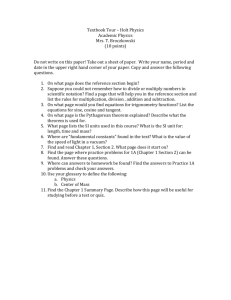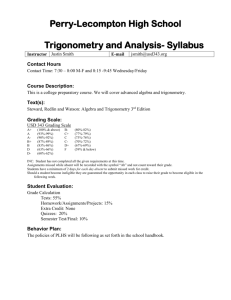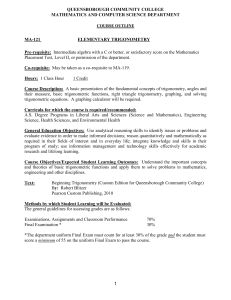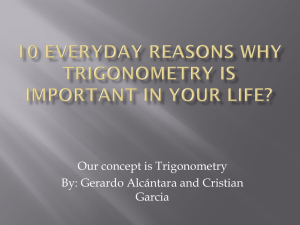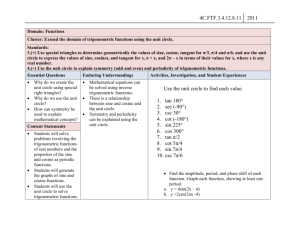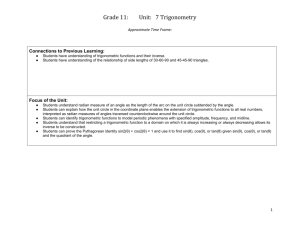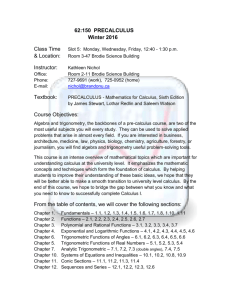40. Why is the unit circle important?
advertisement
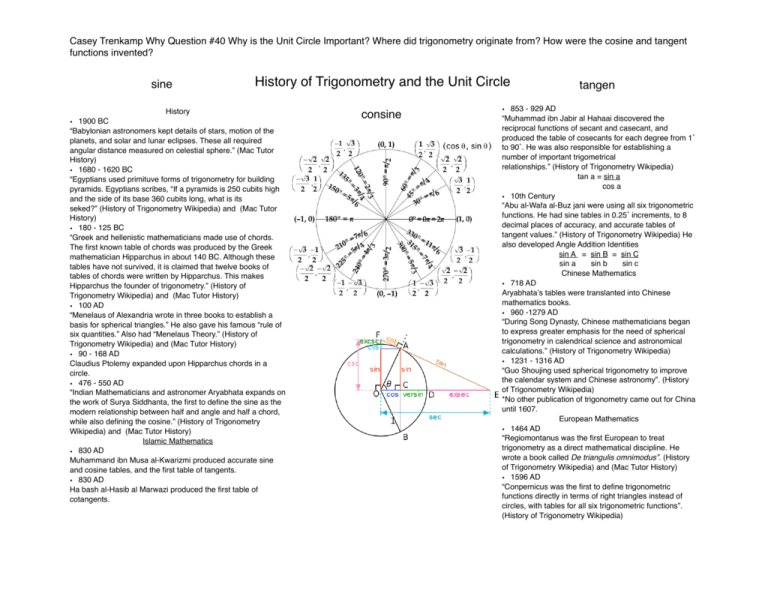
Casey Trenkamp Why Question #40 Why is the Unit Circle Important? Where did trigonometry originate from? How were the cosine and tangent functions invented? sine History of Trigonometry and the Unit Circle History • 1900 BC “Babylonian astronomers kept details of stars, motion of the planets, and solar and lunar eclipses. These all required angular distance measured on celestial sphere.” (Mac Tutor History) • 1680 - 1620 BC “Egyptians used primituve forms of trigonometry for building pyramids. Egyptians scribes, “If a pyramids is 250 cubits high and the side of its base 360 cubits long, what is its seked?” (History of Trigonometry Wikipedia) and (Mac Tutor History) • 180 - 125 BC “Greek and hellenistic mathematicians made use of chords. The first known table of chords was produced by the Greek mathematician Hipparchus in about 140 BC. Although these tables have not survived, it is claimed that twelve books of tables of chords were written by Hipparchus. This makes Hipparchus the founder of trigonometry.” (History of Trigonometry Wikipedia) and (Mac Tutor History) • 100 AD “Menelaus of Alexandria wrote in three books to establish a basis for spherical triangles.” He also gave his famous “rule of six quantities.” Also had “Menelaus Theory.” (History of Trigonometry Wikipedia) and (Mac Tutor History) • 90 - 168 AD Claudius Ptolemy expanded upon Hipparchus chords in a circle. • 476 - 550 AD “Indian Mathematicians and astronomer Aryabhata expands on the work of Surya Siddhanta, the first to define the sine as the modern relationship between half and angle and half a chord, while also defining the cosine.” (History of Trigonometry Wikipedia) and (Mac Tutor History) Islamic Mathematics • 830 AD Muhammand ibn Musa al-Kwarizmi produced accurate sine and cosine tables, and the first table of tangents. • 830 AD Ha bash al-Hasib al Marwazi produced the first table of cotangents. consine tangen • 853 - 929 AD “Muhammad ibn Jabir al Hahaai discovered the reciprocal functions of secant and casecant, and produced the table of cosecants for each degree from 1˚ to 90˚. He was also responsible for establishing a number of important trigometrical relationships.” (History of Trigonometry Wikipedia) tan a = sin a cos a • 10th Century “Abu al-Wafa al-Buz jani were using all six trigonometric functions. He had sine tables in 0.25˚ increments, to 8 decimal places of accuracy, and accurate tables of tangent values.” (History of Trigonometry Wikipedia) He also developed Angle Addition Identities sin A = sin B = sin C sin a sin b sin c Chinese Mathematics • 718 AD Aryabhataʼs tables were translanted into Chinese mathematics books. • 960 -1279 AD “During Song Dynasty, Chinese mathematicians began to express greater emphasis for the need of spherical trigonometry in calendrical science and astronomical calculations.” (History of Trigonometry Wikipedia) • 1231 - 1316 AD “Guo Shoujing used spherical trigonometry to improve the calendar system and Chinese astronomy”. (History of Trigonometry Wikipedia) *No other publication of trigonometry came out for China until 1607. European Mathematics • 1464 AD “Regiomontanus was the first European to treat trigonometry as a direct mathematical discipline. He wrote a book called De triangulis omnimodus”. (History of Trigonometry Wikipedia) and (Mac Tutor History) • 1596 AD “Conpernicus was the first to define trigonometric functions directly in terms of right triangles instead of circles, with tables for all six trigonometric functions”. (History of Trigonometry Wikipedia) Casey Trenkamp Why Question #40 Why is the Unit Circle Important? Where did trigonometry originate from? How were the cosine and tangent functions invented? Work Cited List http://en.wikipedia.org/wiki/Law_of_cosines Though the notion of cosine was not yet developed in his time, Euclid's Elements, dating back to the 3rd century BC, contains an early geometric theorem equivalent to the law of cosines. The case of obtuse triangle and acute triangle (corresponding to the two cases of negative or positive cosine) are treated separately, in Propositions 12 and 13 of Book 2. Trigonometric functions and algebra (in particular negative numbers) being absent in Euclid's time, the statement has a more geometric flavor: It was not until the development of modern trigonometry in the Middle Ages by Muslim mathematicians, especially the discovery of the cosine, that the general law of cosines was formulated. The Persian astronomer and mathematician al-Battani generalized Euclid's result to spherical geometry at the beginning of the 10th century, which permitted him to calculate the angular distances between stars. In the 15th century, al-Kashi in Samarqand computed trigonometric tables to great accuracy and provided the first explicit statement of the law of cosines in a form suitable for triangulation. In France, the law of cosines is still referred to as the theorem of Al-Kashi. The theorem was popularised in the Western world by François Viète in the 16th century. At the beginning of the 19th century, modern algebraic notation allowed the law of cosines to be written in its current symbolic form. http://en.wikipedia.org/wiki/Islamic_mathematics#Trigonometric_functions In the early 9th century, Muhammad ibn Mūsā al-Khwārizmī (c. 780-850) produced tables for the trigonometric functions of sines and cosine,[75] and the first tables for tangents.[76] In 830, Habash al-Hasib al-Marwazi produced the first tables of cotangents as well as tangents.[74][77] Muhammad ibn Jābir al-Harrānī al-Battānī (853-929) discovered the reciprocal functions of secant and cosecant, and produced the first table of cosecants, which he referred to as a "table of shadows" (in reference to the shadow of a gnomon), for each degree from 1° to 90°.[74] By the 10th century, in the work of Abū al-Wafā' al-Būzjānī (959-998), Muslim mathematicians were using all six trigonometric functions, and had sine tables in 0.25° increments, to 8 decimal places of accuracy, as well as accurate tables of tangent values. Jamshīd al-Kāshī (1393-1449) gives trigonometric tables of values of the sine function to four sexagesimal digits (equivalent to 8 decimal places) for each 1° of argument with differences to be added for each 1/60 of 1°.[78] In one of his numerical approximations of π, he correctly computed 2π Casey Trenkamp Why Question #40 Why is the Unit Circle Important? Where did trigonometry originate from? How were the cosine and tangent functions invented? to 9 sexagesimal digits.[79] In order to determine sin 1°, al-Kashi discovered the following triple-angle formula often attributed to François Viète in the 16th century:[80] Images http://upload.wikimedia.org/wikipedia/commons/thumb/9/9d/Circle-trig6.svg/500px-Circle-trig6.svg.png http://en.wikipedia.org/wiki/Muhammad_ibn_Mūsā_al-Khwārizmī#Trigonometry In trigonometry, al-Khwārizmī (c. 780-850) produced tables for the trigonometric functions of sines and cosine in the Zīj al-Sindhind,[23] alongside the first tables for tangents. He was also an early pioneer in spherical trigonometry, and wrote a treatise on the subject.[19] http://en.wikipedia.org/wiki/Al-Kashi In French, the law of cosines is named Théorème d'Al-Kashi (Theorem of Al-Kashi), as al-Kashi was the first to provide an explicit statement of the law of cosines in a form suitable for triangulation. http://en.wikipedia.org/wiki/Trigonometric_functions In mathematics, the trigonometric functions (also called circular functions) are functions of an angle. They are used to relate the angles of a triangle to the lengths of the sides of a triangle. Trigonometric functions are important in the study of triangles and modeling periodic phenomena, among many other applications. The most familiar trigonometric functions are the sine, cosine, and tangent. The sine function takes an angle and tells the length of the ycomponent (rise) of that triangle. The cosine function takes an angle and tells the length of x-component (run) of a triangle. The tangent function takes an angle and tells the slope (y-component divided by the x-component). More precise definitions are detailed below. Trigonometric functions are commonly defined as ratios of two sides of a right triangle containing the angle, and can equivalently be defined as the lengths of various line segments from a unit circle. More modern definitions express them as infinite series or as solutions of certain differential equations, allowing their extension to arbitrary positive and negative values and even to complex numbers. Trigonometric functions have a wide range of uses including computing unknown lengths and angles in triangles (often right triangles). In this use, trigonometric functions are used for instance in navigation, engineering, and physics. A common use in elementary physics is resolving a vector Casey Trenkamp Why Question #40 Why is the Unit Circle Important? Where did trigonometry originate from? How were the cosine and tangent functions invented? into Cartesian coordinates. The sine and cosine functions are also commonly used to model periodic function phenomena such as sound and light waves, the position and velocity of harmonic oscillators, sunlight intensity and day length, and average temperature variations through the year. In modern usage, there are six basic trigonometric functions, tabulated here with equations that relate them to one another. Especially with the last four, these relations are often taken as the definitions of those functions, but one can define them equally well geometrically, or by other means, and then derive these relations. http://en.wikipedia.org/wiki/Unit_circle Using the unit circle, the values of any trigonometric function for many angles other than those labeled can be calculated without the use of a calculator by using the Sum and Difference Formulas. http://en.wikipedia.org/wiki/History_of_trigonometry Although there is no trigonometry in the works of Euclid and Archimedes, in the strict sense of the word, there are theorems presented in a geometric way (rather than a trigonometric way) that are equivalent to specific trigonometric laws or formulas.[6] For instance, propositions twelve and thirteen of book two of the Elements are the laws of cosine for obtuse and acute angles, respectively. Theorems on the lengths of chords are applications of the law of sines. And Archimedes' theorem on broken chords is equivalent to formulas for sines of sums and differences of angles. http://en.wikipedia.org/wiki/History_of_trigonometry History of trigonometry Casey Trenkamp Why Question #40 Why is the Unit Circle Important? Where did trigonometry originate from? How were the cosine and tangent functions invented? http://www-history.mcs.st-andrews.ac.uk/HistTopics/Trigonometric_functions.html The use of trigonometric functions arises from the early connection between mathematics and astronomy. Early work with spherical triangles was as important as plane triangles. The first work on trigonometric functions related to chords of a circle. Given a circle of fixed radius, 60 units were often used in early calculations, then the problem was to find the length of the chord subtended by a given angle. For a circle of unit radius the length of the chord subtended by the angle x was 2sin (x/2). The first known table of chords was produced by the Greek mathematician Hipparchus in about 140 BC. Although these tables have not survived, it is claimed that twelve books of tables of chords were written by Hipparchus. This makes Hipparchus the founder of trigonometry. The next Greek mathematician to produce a table of chords was Menelaus in about 100 AD. Menelaus worked in Rome producing six books of tables of chords which have been lost but his work on spherics has survived and is the earliest known work on spherical trigonometry. Menelaus proved a property of plane triangles and the corresponding spherical triangle property known the regula sex quantitatum. Casey Trenkamp Why Question #40 Why is the Unit Circle Important? Where did trigonometry originate from? How were the cosine and tangent functions invented? Ptolemy was the next author of a book of chords, showing the same Babylonian influence as Hipparchus, dividing the circle into 360° and the diameter into 120 parts. The suggestion here is that he was following earlier practice when the approximation 3 for π was used. Ptolemy, together with the earlier writers, used a form of the relation sin2 x + cos2 x = 1, although of course they did not actually use sines and cosines but chords. Time line of Trigonometry The Beginning 1900 BC “Babylonian astronomers ket details of stars, motion of the planets, and solar and lunar eclipses. These all required angular distance measured on celestial sphere.” (Mac Tutor History) 1680 - 1620 BC “Egyptians used primituve forms of trigonometry for building pyramids. Egyptians scribes, “If a pyramids is 250 cubits high and the side of its base 360 cubits long, what is its seked?” (History of Trigonometry Wikipedia) and (Mac Tutor History) 180 - 125 BC “Greek and hellenistic mathematicians made use of chords. The first known table of chords was produced by the Greek mathematician Hipparchus in about 140 BC. Although these tables have not survived, it is claimed that twelve books of tables of chords were written by Hipparchus. This makes Hipparchus the founder of trigonometry.” (History of Trigonometry Wikipedia) and (Mac Tutor History) 100 AD “Menelaus of Alexandria wrote in three books to establish a basis for spherical triangles.” He also gave his famous “rule of six quantities.” Also had “Menelaus Theory.” (History of Trigonometry Wikipedia) and (Mac Tutor History) 90 - 168 AD Claudius Ptolemy expanded upon Hipparchus chords in a circle. 476 - 550 AD “Indian Mathematicians and astronomer Aryabhata expands on the work of Surya Siddhanta, the first to define the sine as the modern relationship between half and angle and half a chord, while also defining the cosine.” (History of Trigonometry Wikipedia) and (Mac Tutor History) Casey Trenkamp Why Question #40 Why is the Unit Circle Important? Where did trigonometry originate from? How were the cosine and tangent functions invented? Islamic Mathematics 830 AD Muhammand ibn Musa al-Kwarizmi produced accurate sine and cosine tables, and the first table of tangents. 830 AD Ha bash al-Hasib al Marwazi produced the first table of cotangents. 853 - 929 AD “Muhammad ibn Jabir al Hahaai discovered the reciprocal functions of secant and casecant, and produced the table of cosecants for each degree from 1˚ to 90˚. He was also responsible for establishing a number of important trigometrical relationships.” (History of Trigonometry Wikipedia) tan a = sin a cos a 10th Century “Abu al-Wafa al-Buz jani were using all six trigonometric functions. He had sine tables in 0.25˚ increments, to 8 decimal places of accuracy, and accurate tables of tangent values.” (History of Trigonometry Wikipedia) He also developed Angle Addition Identities sin A = sin B = sin C sin a sin b sin c Chinese Mathematics 718 AD Aryabhataʼs tables were translanted into Chinese mathematics books. 960 -1279 AD “During Song Dynasty, Chinese mathematicians began to express greater emphasis for the need of spherical trigonometry in calendrical science and astronomical calculations.” (History of Trigonometry Wikipedia) Casey Trenkamp Why Question #40 Why is the Unit Circle Important? Where did trigonometry originate from? How were the cosine and tangent functions invented? 1231 - 1316 AD “Guo Shoujing used spherical trigonometry to improve the calendar system and Chinese astronomy”. (History of Trigonometry Wikipedia) *No other publication of trigonometry came out for China until 1607. European Mathematics 1464 AD “Regiomontanus was the first European to treat trigonometry as a direct mathematical discipline. He wrote a book called De triangulis omnimodus”. (History of Trigonometry Wikipedia) and (Mac Tutor History) 1596 AD “Conpernicus was the first to define trigonometric functions directly in terms of right triangles instead of circles, with tables for all six trigonometric functions”. (History of Trigonometry Wikipedia)
